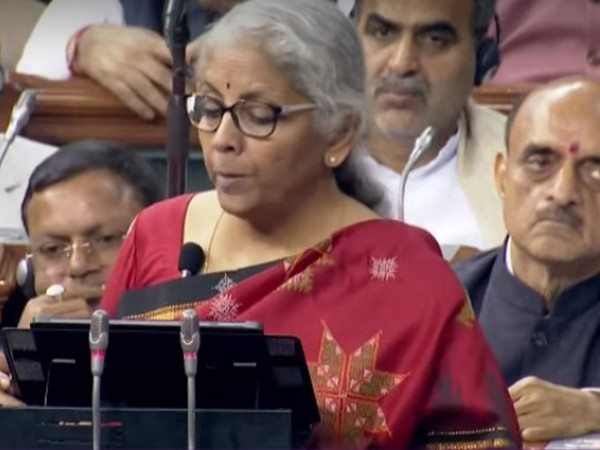Indian Constitution is a guide to the whole world: LS Speaker Om Birla
Lok Sabha Speaker Om Birla on Saturday said that the Indian Constitution is the guide to the whole world and "we are proud of our Constitution".
Replying to a general discussion on the Budget in the Lok Sabha, the Union finance minister said the Union Budget 2023-24 balances the requirements of development imperatives within the limits of fiscal prudence.

[Photo: Twitter/@ANI]
Finance Minister Nirmala Sitharaman on Friday said the Union Budget 2023-24 balances the requirements of India’s development imperatives within the limits of fiscal prudence, without compromising on India’s growth potential, while Government steps have brought down consumer inflation to a tolerance level of below six per cent.
Replying to a general discussion on the Budget in the Lok Sabha, she said that in spite of the difficult times the country had faced due to the Covid-19 pandemic and the Ukraine war, the Indian economy was still the fastest growing major economy in the world and would continue to be so in the coming financial year.
Sitharaman said the Budget has provided Rs 17.98 lakh crore to be transferred to states during 2023-24. This would be Rs 1.55 lakh crore higher than the revised amount for the current financial year (2022-23), ending on 31st March. It would be Rs 2.91 lakh crore more than the actual 2021-22 expenditure also, she said.
Advertisement
Realising the multiplier effect of capital expenditure (Capex) on jobs and economic activity, the Budget has provided a record Capex allocation of Rs 10 lakh crore, she said. Capex was just Rs 3.39 lakh crore in 2019-20, and Rs 2.91 lakh crore in the last full Budget of UPA rule in 2013-14.
The finance minister said the states will be partners in this massive capital expenditure exercise and the Budget has provided Rs 1.30 lakh crore for interest-free 50-year loans to the states. The states’ interests have been kept in mind, she said.
She said growth in 2023-24 will be maintained with policies like PM Gatishakti, National Logistics Policy and the PLI Scheme, along with cooperative federalism empowering the States. Answering members’ queries about the resources allocated for the states, she said the government had taken care of the states’ fiscal health and ensured that money would be in their hands when they needed it.
The finance minister said the Budget had to achieve a difficult balance, a very delicately tight balance, but this was achieved while observing the fiscal prudence path outlined two years ago.
The economy was deeply affected by the pandemic and the government opted for the Capex route as it could generate jobs, triggering better incomes and consumption. The method was considered better than the path recommended by some economists who wanted money to be put in the hands of consumers with much less possibilities of the multiplier effect.
The government took steps to enhance productive capacity in the economy to spur and sustain domestic demand. Another approach was for social security through inflation management, she said.
Listing the Budget priorities, the finance minister said for the middle class, a new tax regime has been proposed with no tax for income less than Rs 7 lakh; the tax exemption limit was raised to Rs 3 lakh under the new regime, against Rs 2.50 lakh earlier. Standard deduction has been extended to the salaried in the new regime and this will reduce tax liability.
She said the new tax regime will be the default, taxpayers will have to opt for the old scheme. Doubling of investment from Rs 15 lakh to Rs 30 lakh has been allowed for the senior citizens’ savings scheme and there is increase in the monthly income scheme limit too with high interest rates. A new 7.50 per cent interest saving scheme for women and girls with a two-year term has been announced. There were similar positive initiatives for employment, MSMEs, agriculture and health.
She said there was no reduction in MGNREGA allocation. In fact, the Budget estimates every year were surpassed by the actual expenditure. In 2019-20, the allocation was Rs 60000 crore and it rose to Rs 71,000 crore in the Revised Estimate and the actual release was even higher.
The next year, the budget estimate was Rs 61,500 crore, but it rose to Rs 1.11 lakh crore in the revised estimates and the actual release was even higher. The following year, Rs 73000 crore was the BE and Rs 98,000 crore the revised estimate. During the current financial year 2022-23, Rs 73000 crore was the budget provision but already Rs 89000 crore is the revised estimate.
Replying to the Congress members, who complained about the MGNREGA allocation in the Budget, she said during 2009-10 in the UPA rule, the budget estimate was Rs 39,100 crore and it remained unchanged in the revised estimate. The next year, Rs 40,100 crore was the BE and it remained unchanged, with the actual expenditure even lower at Rs 35,841 crore. In 2011-12, Rs 40,000 crore was the BE, the RE was lower at 31,000 crore and the actual release Rs 29215 crore. Those who have houses of glass, should think before making political charges against others, she said.
She told MPs from West Bengal that no funds were held up for the State. West Bengal delayed AG’s accounting reports for several years across many important schemes, preventing the release of subsequent allocations by the Central government.
“We don’t do vote-bank politics,” the finance minister asserted. Those eligible could have any religion, region, there was no discrimination. Minorities were given fellowships as per the prime minister’s stress on inclusive development. None had been favoured under the green budget allocations, she said.
The finance minister said if she were to recall history, many unpleasant memories would be revived. During Mrs Indira Gandhi’s time if money was given to Assam there was simultaneous massacre of a community during Nellie election. There was a killing of Sikhs in Delhi.
Advertisement